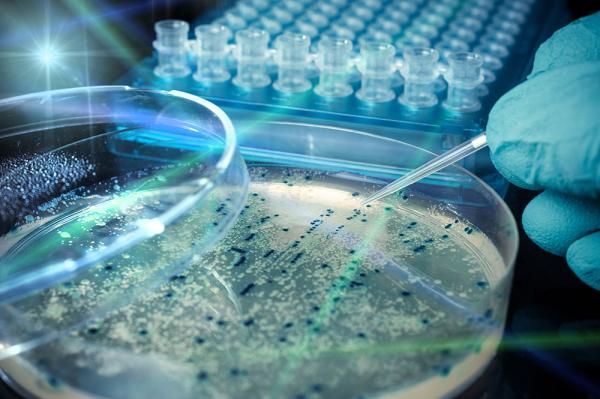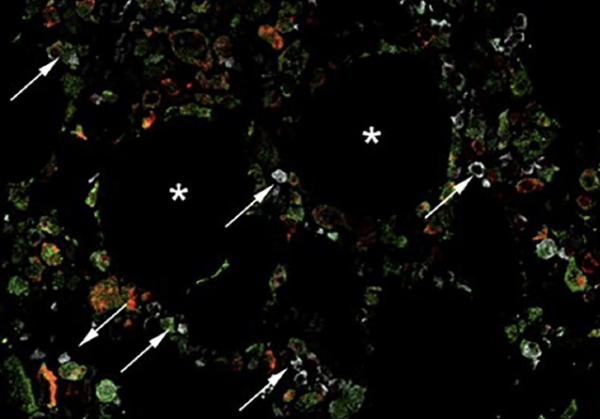Bone Marrow Cells Reveal Secret Weapon to Battle Bacteria
Research Could Lead to Cell-Based Therapies for Infections and Autoimmune Reactions

A recent IRP study revealed that particular cells in our bone marrow produce a substance that kills bacteria and curbs inflammation.
One thing many scientists love about their job is that the topic they study can still surprise them even after decades of research. IRP senior investigator Eva Mezey, M.D., Ph.D., for instance, has spent the last 20 years investigating a particular set of cells in the bone marrow, yet until now she had never uncovered one of their most intriguing tricks. In a recent study, her IRP team and its collaborators discovered that those cells make a substance that can fight infections and tame hyper-active immune responses.1
At this point in her career, Dr. Mezey is no stranger to the odd places scientific inspiration can spring from. In this case, an idea for a new set of experiments was born during dinner with a friend and fellow scientist whose lab focused on fish.
“He started to talk about his interest in fish ever since he was a young man,” she recalls. “He made a living by transporting people’s boats from one place to another, and that’s how he started to study fish. He asked himself how fish protect themselves against bacteria, and he found this small peptide, hepcidin, that fish use to fight bacteria — quite successfully, since there are a lot of bacteria in the ocean.”

If hepcidin can keep fish healthy while they constantly swim through bacteria-infested waters, then it may also play an important role in fighting infections in our own bodies.
Dr. Mezey, the new study’s co-senior author, wondered whether the cells she studies, known as bone marrow stromal cells (BMSCs), might make hepcidin — and if so, what its purpose might be in humans rather than fish. BMSCs give rise to several types of tissue, including bone, cartilage, and fat, and they also nurture the bone marrow’s hematopoietic stem cells, which create new blood and immune cells. Some prior studies had found evidence that similar cells found in human menstrual blood can produce hepcidin, but it was still uncertain whether BMSCs can and, if so, whether they make hepcidin while hanging out in the bone marrow or only when traveling through the blood or growing in petri dishes. If BMSCs could make hepcidin, it would help explain how they protect their blood-producing cellular neighbors in the bone marrow.
“In the bone marrow, if hematopoietic stem cells are attacked by bacteria, their only defense is the bone marrow stromal cells that surround them,” Dr. Mezey explains. “The bone marrow is a very different organ from all the others. You can’t really have a huge invasion of immune cells to fight the bacteria because it’s the same space where all the healthy blood cells need to be made. It’s like the headquarters of the police that send out all the policemen to fight the bad guys, so it must have its own internal defenses.”
In the new study, Dr. Mezey’s team and its collaborators showed that BMSCs located near hematopoietic stem cells in mouse and human bone marrow produce hepcidin. The researchers then grew those BMSCs in petri dishes and exposed them to either live bacteria or inflammation-inducing molecules, called cytokines, that the body releases during an infection. Both the bacteria and the cytokines boosted the cells’ production of hepcidin, suggesting that our BMSCs produce hepcidin in response to a bacterial infection. Further bolstering that idea, the hepcidin produced by human BMSCs could kill bacteria just like the hepcidin Dr. Mezey’s friend had discovered in fish.

The new IRP study showed for the first time that in our bone marrow, BMSCs (red and green) located near blood-producing stem cells (white) produce hepcidin.
That wasn’t the only trick hepcidin had up its sleeve, however. In prior studies, Dr. Mezey’s lab had shown that BMSCs produce a molecule called prostaglandin E that persuades immune cells called macrophages to combat inflammation rather than promote it,2 but “the effect was only partially caused by prostaglandins, and we wondered if hepcidin could also have a role in the same effect,” Dr. Mezey says.
To answer that question, Dr. Mezey’s team put mouse BMSCs and macrophages together in petri dishes and then added a protein found on the surface of bacteria. Some of the BMSCs came from mice with the hepcidin gene and some came from mice that lacked the gene. The experiment revealed that the macrophages produced more of an anti-inflammatory molecule called IL-10 and less of an inflammatory molecule called TNF-alpha when their BMSC roommates had the gene for making hepcidin than when the BMSCs were missing that gene.
“TNF-alpha causes inflammation, and during any disease — even when you have the flu — you have a lot of TNF-alpha circulating and that’s what makes you feel lousy,” Dr. Mezey explains. “IL-10 is the opposite — it’s the good guy. IL-10 calms things down. Since macrophages make most of the TNF-alpha that circulates around the body, if you can get the macrophages to behave, then the disease will go away. The more mechanisms you discover for doing that — hepcidin is one and prostaglandin E is another — the more potential clinical targets you can think about.”

Dr. Eva Mezey
In one last experiment, the researchers injected BMSCs with or without the gene for hepcidin, along with an inflammation-inducing substance, into the abdomens of genetically normal mice. They then counted the number of immune cells that rushed to the site of the injection, which indicates how much inflammation is occurring there. Noticeably fewer immune cells came to the injection site in mice that received injections of BMSCs capable of making hepcidin compared to when the BMSCs lacked the gene for hepcidin, confirming that hepcidin produced by BMSCs can tame inflammation-induced immune responses.
Altogether, the new study’s results don’t just explain why BMSCs in our bone marrow make hepcidin, but also point to the potential of BMSCs or the hepcidin they produce as a treatment for severe bacterial infections and other situations in which immune cells release large amounts of inflammation-inducing molecules like TNF-alpha.
“Imagine a smart medicine that would find disease-appropriate ways to combat illnesses,” Dr. Mezey says. “BMSCs seem to act this way. If they detect too much TNF-alpha in the blood, they force macrophages to adopt an anti-inflammatory role and make IL-10. They are a live sensor and responder, which makes them incredibly unique. Given intravenously, they could be uniquely useful therapeutic agents.”
Subscribe to our weekly newsletter to stay up-to-date on the latest breakthroughs in the NIH Intramural Research Program.
References:
[1] Krepuska M, Mayer B, Vitale-Cross L, Myneni VD, Boyajian MK, Németh K, Szalayova I, Cho T, Mc Clain-Caldwell I, Gingerich AD, Han H, Westerman M, Rada B, Mezey É. Bone marrow stromal cell-derived hepcidin has antimicrobial and immunomodulatory activities. Sci Rep. 2024 Feb 17;14(1):3986. doi: 10.1038/s41598-024-54227-1.
[2] Németh K, Leelahavanichkul A, Yuen PS, Mayer B, Parmelee A, Doi K, Robey PG, Leelahavanichkul K, Koller BH, Brown JM, Hu X, Jelinek I, Star RA, Mezey E. Bone marrow stromal cells attenuate sepsis via prostaglandin E(2)-dependent reprogramming of host macrophages to increase their interleukin-10 production. Nat Med. 2009 Jan;15(1):42-9. doi: 10.1038/nm.1905.
Related Blog Posts
This page was last updated on Tuesday, May 7, 2024
